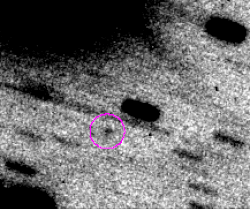Mean orbit radius 20,901,000 km Discovered 2001 | Eccentricity 0.3682 Orbital period 2,887 days | |
 | ||
Discovered by Matthew J. HolmanJohn J. KavelaarsDan MilisavljevicBrett J. Gladman Discovery date August 13, 2001 (confirmed in 2003) Discoverers Dan Milisavljevic, John J. Kavelaars, Brett J. Gladman, Scott S. Sheppard, Matthew J. Holman, David C. Jewitt Similar John J Kavelaars discoveries, Uranus moons, Other celestial objects | ||
Ferdinand (/ˈfɜːrdᵻnænd/ FUR-də-nand) is the outermost retrograde irregular satellite of Uranus. It was discovered by Matthew J. Holman, John J. Kavelaars, Dan Milisavljevic, and Brett J. Gladman on August 13, 2001, and given the provisional designation S/2001 U 2.
Despite being seen again on September 21 and November 15 and even a year later on August 13 and September 5, 2002, it was eventually lost. It was finally recovered on September 24, 2003, by Scott S. Sheppard on images obtained by David C. Jewitt and himself on August 29 – 30 and September 20 of that year. Confirming observations were made by Holman on September 30.
Designated Uranus XXIV, it was named after the son of the King of Naples in William Shakespeare's play The Tempest.
Orbit
Ferdinand is the most distant known satellite of Uranus. It follows a retrograde, modestly inclined but highly eccentric orbit. The diagram illustrates the orbital parameters of the retrograde irregular satellites of Uranus (in polar co-ordinates) with the eccentricity of the orbits represented by the segments extending from the pericentre to the apocentre.
